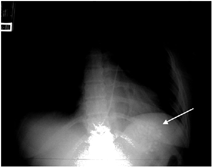To the Editor:
Medications reported to cause bezoars include aluminium hydroxide gel, sucralfate, nifedipine, meprobamate cholestyramine, or amitriptyline Citation1&2. In the present case, the bezoar formation avoided significant severe side effect after a potential lethal poisoning with beta-blocker, digitalis, and amitriptyline.
Case Report
A 32-yr-old female working as a nurse in an emergency department was admitted to the ICU after massive ingestion of metoprolol, amitriptyline, and digoxin. She had a previous history of depression and had been hospitalized several times for acute poisoning. Her usual medications were amitriptyline and cymamemazine. Several weeks before ingestion she collected numerous tablets of metoprolol and digoxin stolen from the cardiologic ward. On the morning of her admission, she put 115 tablets of metoprolol (11150 mg), 50 tablets of amitriptyline, 75 mg (3750 mg), and 25 tablets of digoxin (2.25 mg) in a bowl and threw away the empty boxes. She ingested all the tablets at 11 a.m. Four hours later she felt no significant effect except vomiting, and called a friend. She was then referred to the emergency ward.
Her clinical examination showed no neurological alteration. Her arterial blood pressure was 140/80 mmHg, her heart rate was 60 beats per min. EKG showed sinus rhythm, PR space of 22 msec, and QT space of 0.36 msec. Plasma laboratory tests were the following: glucose = 6.2 mmol/L; sodium = 132 mmol/L; potassium = 6.2 mmol/L; chloride = 96 mmol/L; bicarbonate = 25 mmol/L; creatinine = 122 µmol/L; AST = 195 UI/L; ALT = 100 UI/L; alkaline phosphatases = 97 UI/L; bilirubin = 6 µmol/L. Plasma digoxin level was 12.10 ng per mL. Plasma metoprolol chromatographic analysis performed the next day of admission was 30 μg per mL. Urine qualitative determination was positive only for tricyclic antidepressant. She had a gastric lavage and received activated charcoal administration, and she was admitted to the ICU for monitoring. She received 480 mg of digoxin antibodies. Six hours later she had no hemodynamic disorder, her heart rate was 45 per min. EKG showed sinus rhythm with normal QRS complex and QT space. The thoracic X-ray performed after gastric emptying showed bezoar (). During the first 2 days of hospitalization she received 50 g of activated charcoal every 4 h and 4 L of polyethylene glycol. Abdominal X-ray showed the progressive desintegration of the bezoar. Gastric fibroscopy was not performed. Four days after her admission, clinical examination showed no abnormality, and she was transferred to a psychiatric ward.
Discussion
Medications reported to cause bezoars include aluminium hydroxide gel, sucralfate, cholestyramine, nifedipine XL, meprobamate, theophylline enteral feeding formulas, and amitriptyline Citation1-4. Bowel hypoactivity, dehydration, and concomitant use of anticholinergic and narcotics may contribute to the ability to form bezoars Citation2. In the present case, amitriptyline's atropinic side effects on the gut can be the causal factor for this bezoar formation Citation4. In patients with pharmacobezorar, life-threatening overdose can be underestimated and sustained-release can be responsible for delayed fatality Citation3. In the contrary, in the present case, the hypothesis of a protective effect by the formation of medication bezoar has been evoked. In this case, the low plasma metoprolol level could be explained by late sampling or by overestimated ingested quantities. Furthermore, the spontaneous vomiting may have removed part of the ingested medication. However the direct visualization of numerous tablets on X-ray strongly suggested the massive ingestion. The treatment with digoxin antibodies may have also contributed to minimize the cardiac-induced risk of severe failure. In the present case, the patient received polyethylene glycol administration to induce digestive epuration as it had been used in a patients with tablet bezoar in verapamil poisoning Citation5. In summary, in this case, pharmacobezoar had probably minimized the severity of a massive intoxication with digoxin and beta-blocking agents and may have contributed in saving the patient's life.
Sincerely,
René Robert, Jean-Pierre Frat, and Anne Veinstein
Service de Réanimation Médicale
Hopital Jean Bernard
CHU Poitiers 86021 Poitiers cedex France
Jean Rouffineau
Service des Urgences
Hospital Jean Bernard
CHU Poitiers 86021 Poitiers cedex France
References
- Taylor J R, Streetman D S, Casle S S. Medication bezoars: a literature review and report of a case.Ann Pharmacother 1998; 32:940–946., [PUBMED], [INFOTRIEVE], [CSA]
- Stack P E, Thomas E. Pharmacobezoar: an evolving new entity.Dig Dis 1995; 13:356–364., [PUBMED], [INFOTRIEVE], [CSA]
- Bernstein G, Jehle D, Bernaski E, Braen G R. Failure of gastric emptying and charcoal administration in fatal sustained-release theophylline overdose: pharmacobezoar formation.Ann Emerg Med 1992; 21:1388–1390., [PUBMED], [INFOTRIEVE], [CSA], [CROSSREF]
- Ray M J, Radin D R, Condie J D, Halls J M, Padin D R. Charcoal bezoar. Small-bowel obstruction secondary to amitriptyline overdose therapy.Dig Dis Sci 1988; 33:106–107., [PUBMED], [INFOTRIEVE], [CSA], [CROSSREF]
- Buckley N, Dawson A H, Howarth D, Whyte I M. Slow-release verapamil poisoning. Use of polyethylene glycol whole-bowel lavage and high-dose calcium.Med J Aust 1993; 158:202–203., [PUBMED], [INFOTRIEVE], [CSA]
